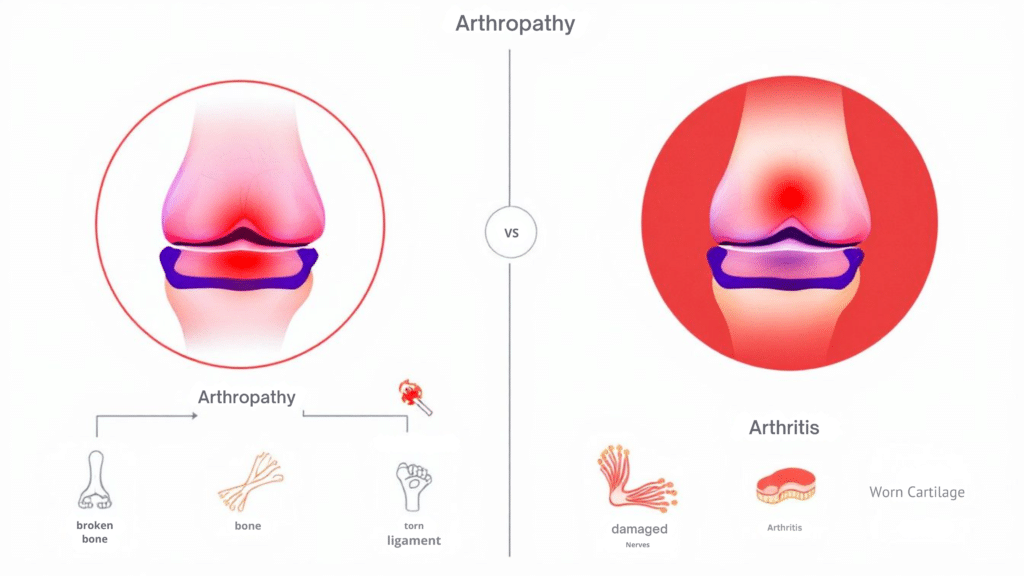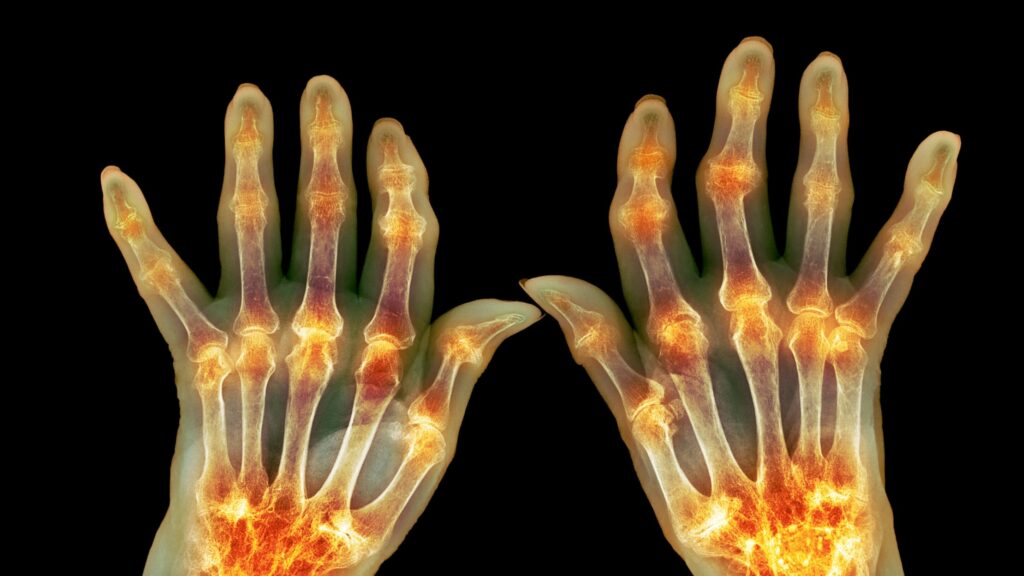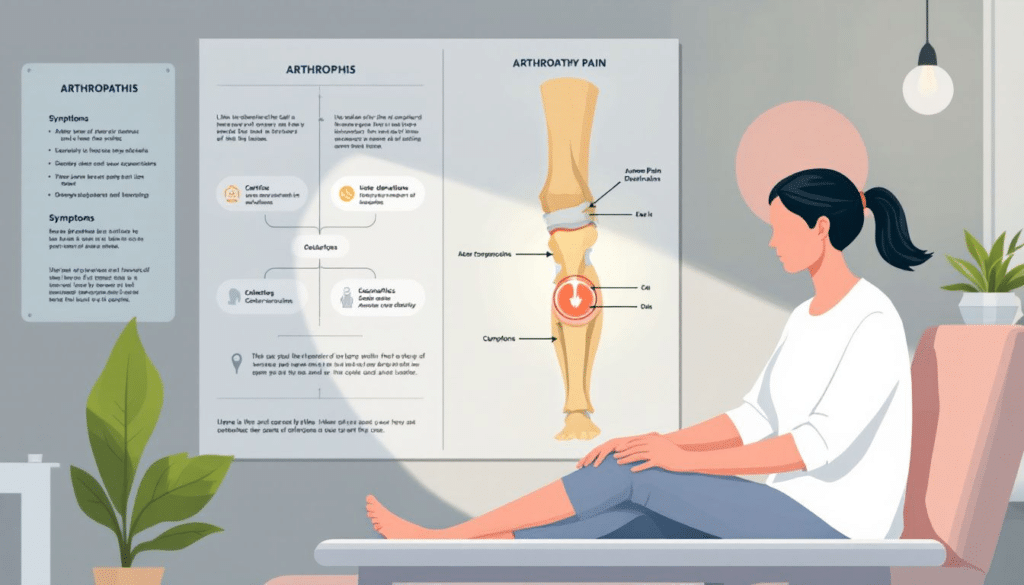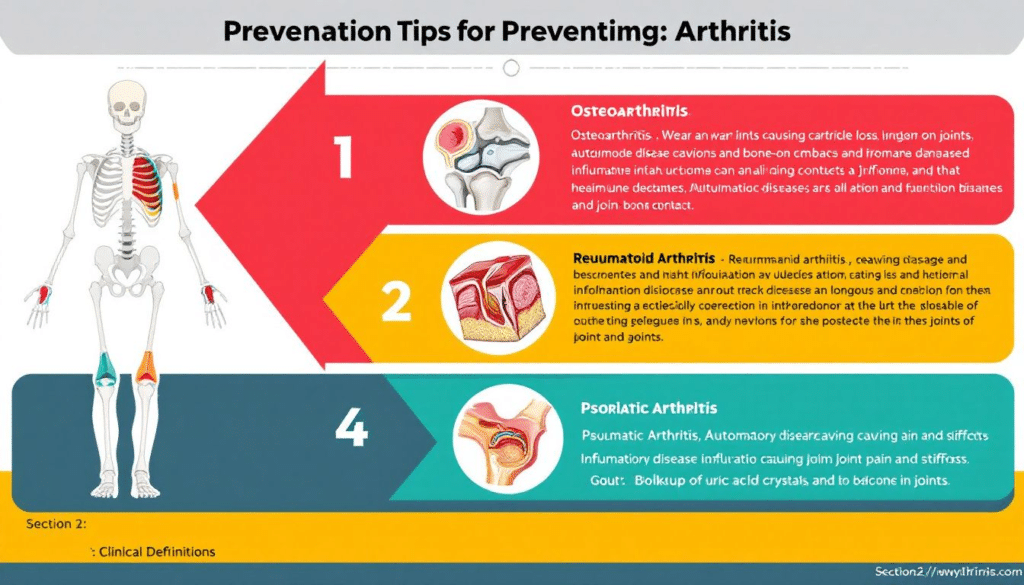Understanding the difference between arthropathy vs arthritis is crucial for effective diagnosis and treatment. While both involve joint issues, arthropathy refers to any joint disease, whereas arthritis specifically involves joint inflammation. This article will explore these differences, types, symptoms, diagnosis methods, and treatment options for both conditions. Read on to learn how to manage and differentiate these common joint issues.
Key Takeaways
Arthritis is a specific type of joint disease characterized by inflammation, whereas arthropathy encompasses a broader range of joint disorders, including degenerative conditions.
Common forms of arthritis include osteoarthritis, rheumatoid arthritis, and gout, each with distinct causes and symptoms, primarily involving joint pain and reduced mobility.
Effective diagnosis and treatment strategies for both arthropathy and arthritis are crucial, utilizing methods such as radiographic evaluations and various medications, along with lifestyle modifications for symptom management.
Defining Arthropathy and Arthritis

Arthritis encompasses a wide range of conditions, making it a broad and complex topic. There are many types and subtypes of arthritis, all of which involve joint inflammation. Rheumatoid arthritis, for instance, is caused by an autoimmune response to environmental triggers and can lead to systemic repercussions, affecting other organs. Osteoarthritis, on the other hand, is characterized by progressive cartilage loss, bone damage, subchondral cysts, and osteophytes.
Arthropathy, in contrast, refers to any disease affecting the joints. While arthritis is a form of joint disease, arthropathy encompasses a wider range of joint disorders, including degeneration and structural abnormalities. This distinction is crucial for understanding the different ways these conditions can impact the body.
Both terms describe joint-related issues, but the specifics can vary dramatically. Arthritis typically involves painful, inflamed joints, whereas arthropathy might not always cause pain. Understanding these nuances is essential for accurate diagnosis and effective treatment.
Types of Arthropathy
Arthropathy can manifest in various forms, beyond just inflammation. Degeneration and structural abnormalities are also common aspects of this condition. One notable type is facet arthropathy, which refers to arthritis in the facet joints of the spine. This condition is primarily caused by joint degeneration due to wear and tear, and it can lead to significant discomfort and joint mobility issues.
Facet arthropathy often results from small, undiagnosed fractures, disc tears, and cartilage damage. The pain from this condition can radiate laterally towards the knee and is frequently aggravated by movements like extension and rotation of the spine. The inflamed synovial fluid capsule around the facet joints increases pressure on spinal nerves, contributing to discomfort.
Psoriatic arthritis is another form of arthropathy, associated with psoriasis. This condition leads to significant joint inflammation and potential damage if left untreated, affecting the arthritic joint. Each type of arthropathy presents unique challenges and requires specific management strategies.
Common Forms of Arthritis

Osteoarthritis is the most prevalent form of arthritis in the American population, affecting over 32.5 million people. Advancing age and female sex are common causes. Other factors include joint trauma, obesity, and genetic influences. This degenerative arthritis primarily results from the progressive loss of cartilage, leading to joint pain and stiffness.
Rheumatoid arthritis, impacting more than 1.3 million people, is an autoimmune condition with a higher prevalence in women. This form of arthritis can particularly affect the facet joints in the mid to lower lumbar regions. The autoimmune response leads to chronic inflammation, causing joint damage and deformity over time.
Gout is another common form of arthritis, primarily caused by the crystallization of monosodium urate salts. Symptoms often first appear in the big toe and can be triggered by dietary factors and medications. While each form of arthritis has distinct characteristics, they all involve joint pain and reduced mobility.
Symptoms Comparison
Arthritis specifically involves inflammation of the joints, leading to pain, swelling, loss of function, stiffness, deformity, weakness, instability, fatigue, and sleep disturbance. Symptoms of inflammatory arthritis during a physical examination may include tenderness, swelling, effusion, erythema, and warmth.
In contrast, arthropathy refers to any disease affecting the joints, and its symptoms can vary widely. Some types of arthropathy may not necessarily cause pain, while arthritis is typically associated with painful symptoms. For instance, patients with facet arthropathy may experience neck pain that radiates to the upper neck, shoulders, and middle back. Morning stiffness and muscle spasms are other potential symptoms.
Overall, arthritis is characterized by painful, swollen, and stiff joints, whereas arthropathy symptoms may range from mild aches to debilitating chronic pain. Understanding these differences is key to identifying the appropriate condition and seeking the right treatment.
Causes and Risk Factors
Aging is a significant contributing factor to arthropathy, as it leads to wear and tear on joints. As people age, a decrease in chondrocyte function occurs, which enhances susceptibility to joint degeneration. Wear and tear as everyone ages contributes to the risk of developing arthropathy.
Trauma or injuries to the spine can accelerate the onset of facet arthropathy. Genetic predisposition also plays a significant role in the development of arthropathy. Obesity increases the load on weight-bearing joints, contributing to joint degeneration.
Comorbid conditions like diabetes mellitus can exacerbate the symptoms of an arthritic condition and arthritis. Lifestyle factors, such as sedentary behavior, can heighten the risk for developing joint issues. Understanding these causes and risk factors can help in the prevention and management of these conditions.
Diagnosis Methods
Accurate diagnosis is crucial for effective treatment of arthropathy and arthritis, as the conditions share similar symptoms. During a physical exam, the physician may assess pain through specific movements and check for tenderness along the spine. Physical examination methods help differentiate arthritis from other sources of pain.
Radiographic evaluation such as X-rays can reveal changes in the spine that suggest facet arthropathy and help identify other potential pain sources. MRI scans are effective for visualizing soft tissues such as discs and nerves that are not visible on X-rays. CT scans provide detailed three-dimensional images of the spine, useful for diagnosing facet arthropathy.
A medial branch block involves injecting numbing medication around the nerves connected to the facet joint to confirm a diagnosis. An 80% improvement in pain following the injection suggests a likely diagnosis of facet arthropathy. This finding supports the diagnosis. These diagnostic methods are essential for developing an effective treatment plan.
Treatment Options

Medications like NSAIDs, aspirin, and specific inhibitors help alleviate pain from facet arthropathy. Non-pharmacological treatments, including topical and oral NSAIDs, capsaicin, duloxetine, corticosteroid injections, and surgery, are common for managing osteoarthritis.
Physical therapy and targeted strengthening exercises are effective non-surgical treatments for facet arthropathy. Physical therapy is beneficial for designing personalized exercise plans that focus on joint function. Total lumbar facet replacement is a new surgical option for severe cases of facet arthropathy.
Stem cell regeneration is an experimental treatment that targets damaged facet joints and aids in repair. Shockwave therapy shows promising results, offering better long-term outcomes compared to steroid injections. These advanced treatment options provide hope for patients suffering from severe joint conditions.
Managing Pain and Inflammation
Low-impact activities like walking or swimming can reduce joint stress while promoting mobility. Engaging in regular exercise strengthens the muscles supporting the spine, contributing to joint stability. Keeping a healthy weight helps reduce strain on the facet joints, lowering the risk of developing facet joint syndrome.
Practicing good posture can alleviate undue pressure on the spine and facet joints, aiding in prevention. Using proper lifting techniques minimizes the risk of injury to the spine and facet joints. Corticosteroid injections can effectively reduce inflammation and pain in arthritic joints.
Heat and ice therapies can provide symptomatic relief for joint pain. Limiting repetitive movements that stress the spine can help reduce the likelihood of facet joint pain degeneration. Maintaining overall spinal health through regular check-ups and therapies supports long-term facet joint integrity.
Prevention Tips

Maintaining a healthy weight is essential to alleviate stress on arthritic joints. Reducing the risk of pain through specific methods is beneficial in preventing facet arthropathy. Implementing these prevention strategies can lead to better management of arthropathy and arthritis symptoms.
Engaging in regular exercises and using proper lifting techniques can significantly reduce the risk of joint issues, particularly in the affected joints. Practicing good posture and avoiding repetitive movements that stress the joints are also crucial prevention measures.
Early intervention and regular check-ups can help maintain joint health and prevent the onset or worsening of arthropathy, arthritis, and other joints.
Summary
Understanding the differences between arthropathy and arthritis is crucial for effective diagnosis and treatment. While both conditions involve joint issues, arthritis typically involves inflammation, whereas arthropathy encompasses a broader range of joint disorders. Recognizing the specific symptoms and causes of each condition can aid in accurate diagnosis and appropriate treatment.
In conclusion, managing and preventing joint diseases involves a combination of medical treatments, physical therapy, lifestyle changes, and preventive measures. By staying informed and proactive, individuals can effectively manage their symptoms and improve their quality of life.
Frequently Asked Questions
What is the main difference between arthropathy and arthritis?
The main difference is that arthritis specifically involves inflammation of the joints, whereas arthropathy encompasses any disease affecting the joints, including non-inflammatory conditions.
What are the common symptoms of arthritis?
The common symptoms of arthritis include joint pain, swelling, stiffness, deformity, weakness, instability, fatigue, and sleep disturbances. Recognizing these signs early is crucial for effective management.
How is facet arthropathy diagnosed?
Facet arthropathy is diagnosed through physical examinations, radiographic evaluations such as X-rays and MRI scans, and diagnostic tests like medial branch blocks. These methods provide a comprehensive assessment of the condition.
What treatment options are available for severe facet arthropathy?
For severe facet arthropathy, effective treatment options include medications, physical therapy, corticosteroid injections, stem cell regeneration, shockwave therapy, and total lumbar facet replacement. Each option should be considered carefully to address individual patient needs.
How can I prevent the onset of arthropathy and arthritis?
To prevent arthropathy and arthritis, it is essential to maintain a healthy weight, engage in regular exercise, practice good posture, and avoid repetitive movements. Implementing these measures can significantly reduce your risk of developing these conditions.


